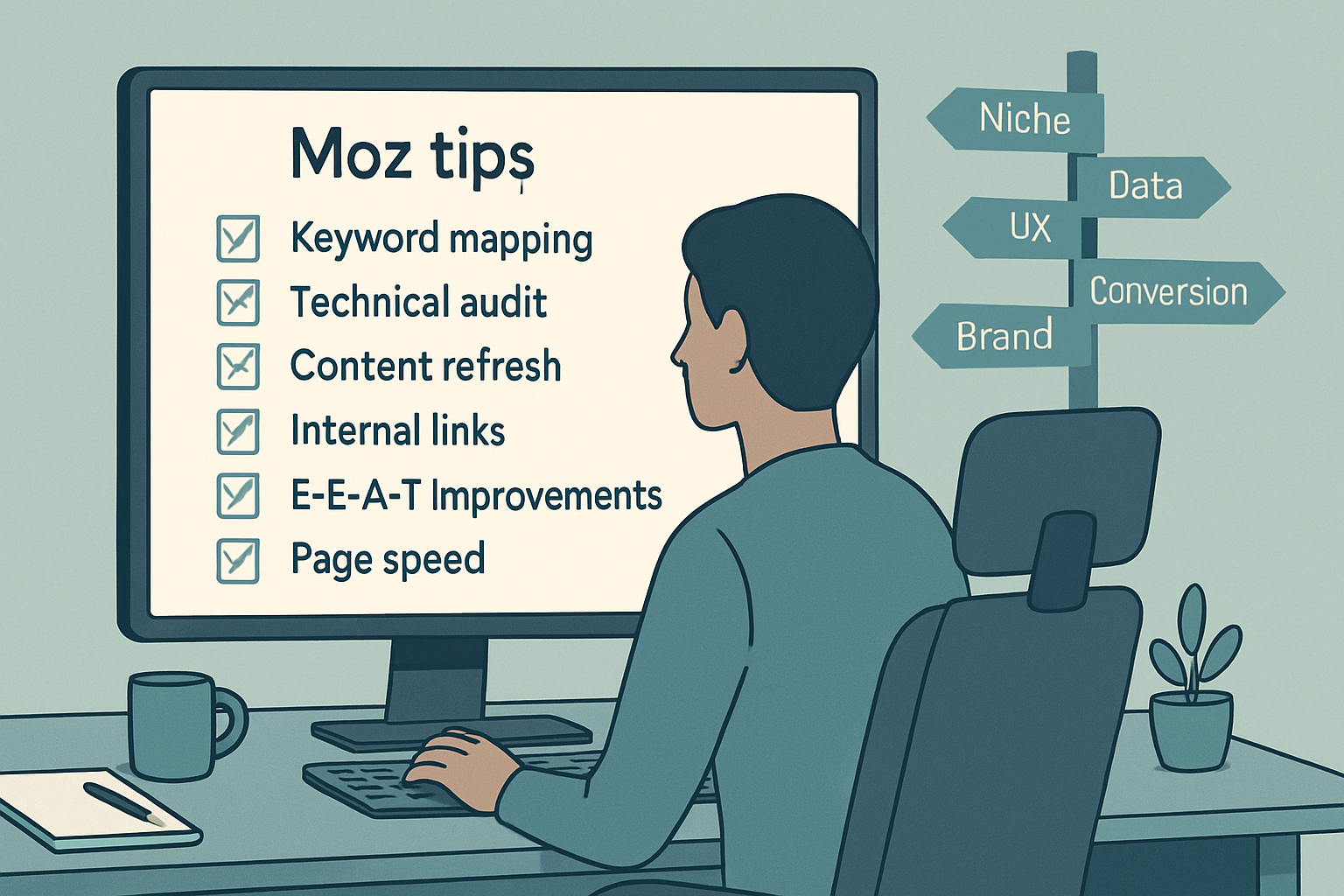· marketing · 8 min read
10 Moz Tips That Every SEO Specialist Should Ignore
A contrarian look at ten commonly‑repeated Moz recommendations - why treating them as universal rules can harm results, when they still make sense, and practical alternatives tuned to niche, business model, and data.

Introduction
Moz is one of SEO’s most respected voices. Their guides and research shape how thousands of teams plan campaigns. But like any authoritative source, Moz writes for a broad audience and often presents best practices that assume typical sites and goals. Treating those best practices as hard rules - rather than starting points - leads to missed opportunities and wasted effort.
This article takes a contrarian look at ten commonly circulated Moz recommendations and explains why you should sometimes ignore them (or at least stop following them blindly). For each item I’ll summarize the advice you’ve probably seen, explain where it breaks down, show when it still applies, and give an actionable alternative you can test.
- “Always include the exact target keyword in the title tag”
Why you see this advice
Moz’s title tag guidance stresses the importance of title tags for relevance and CTR (Moz: Title Tag). A title that matches searcher language feels relevant and can increase clickthrough.
Why to ignore it as a hard rule
Exact-match titles can look unnatural, reduce brand differentiation, and harm CTR when the SERP intent differs from the keyword. For some query classes (local, branded, long-tail, comparative queries), conversational or benefit-led titles outperform exact-match keyword titles.
When it still applies
If your target query is purely informational and searchers expect a literal answer (e.g., “how to reset iPhone”), including the keyword improves perceived relevance.
Actionable alternative
Prioritize user intent and CTR metrics. Use title variants: exact-match, intent-focused, and brand-led. A/B test using search console impression/CTR cohorts or run small paid headline tests to determine which phrasing yields the best combination of clicks and engagement.
Metrics to watch: impressions, CTR, bounce/engagement, ranking changes.
- “Write meta descriptions to improve rankings”
Why you see this advice
Moz recommends writing compelling meta descriptions to improve CTR and provide accurate summaries (Moz: Meta Description).
Why to ignore it as a ranking lever
Google has said meta descriptions are not a direct ranking factor. Their utility is to influence clicks, not to improve ranking directly (Google: Snippet Basics). Spending hours optimizing meta descriptions to evade ranking drops is a poor investment.
When it still applies
For pages with lots of impressions but low CTR, a better meta can lift traffic. Also important for rich result markup and social sharing.
Actionable alternative
Prioritize meta writing where data shows a problem: pages with high impressions and low CTR, or pages where organic traffic is critical and SERP creative could improve conversions. Use templates and pull dynamic CTA elements rather than writing unique descriptions for every low-value page.
- “Aim for a target keyword density on each page”
Why you see this advice
Older SEO guidance and some learning resources still talk about keyword density as a signal of topical relevance.
Why to ignore it
Keyword density is an outdated heuristic. Modern search engines use semantic analysis and entity recognition, not raw keyword frequency. Artificially increasing keyword density risks poor copy quality and a worse UX.
When it still applies
Keep important phrases present in natural locations: title, H1, first 100 words, and naturally in headings/subheadings - but without obsessing over counts.
Actionable alternative
Use content modeling and topical analysis (TF-IDF / semantic tools / NLP topic clusters) to measure coverage vs. competitors. Prioritize semantic breadth and user intent, not raw density.
Tools: NLP topic extractors, content gap analysis, and competitor SERP scraping.
- “Set a fixed backlink acquisition target (X links/month)”
Why you see this advice
Moz and other resources talk about tracking link acquisition as a KPI and maintaining steady link growth (Moz Beginner’s Guide: Link Building).
Why to ignore it as a rigid quota
Links are not fungible. A chase for a numeric target encourages low-quality link schemes, unnatural velocity, and anchor text over-optimization - behaviors that can trigger manual or algorithmic penalties (Google: Link Schemes).
When it still applies
Monitor link growth as an indicator of brand momentum, but don’t hit a blind monthly quota at the expense of quality.
Actionable alternative
Emphasize link quality and relevance: topical authority, referral traffic potential, editorial context, and conversions. Use weighted metrics (referral traffic, domain relevance, engagement) rather than pure counts. Plan campaigns in phases: content-first, then outreach to relevant publishers.
- “Guest blogging is your go-to large-scale link tactic”
Why you see this advice
Guest posting is frequently recommended (and covered by Moz) as a link-building method for exposure and backlinks.
Why to ignore it wholesale
Guest posting en masse produces thin, promotional content and predictable anchors that devalue links over time. Google’s guidance and community experience show that indiscriminate guest posting can become a link-scheme risk.
When it still applies
High-quality guest pieces on authoritative, relevant sites that drive real referral traffic and brand visibility still work. Treat guest posts as brand marketing first, link acquisition second.
Actionable alternative
Diversify link acquisition: digital PR, original research (data-driven studies), partnerships, product integrations, tools/resources that naturally attract links, and outreach that prioritizes referral and conversions. Measure success by clicks and conversions from referrals, not only by links.
- “Optimize every page for featured snippets”
Why you see this advice
Moz coverage of featured snippets shows big traffic wins are possible; many SEOs push snippet optimization as low-hanging fruit.
Why to ignore it for everything
Winning a featured snippet can reduce CTR for some informational queries (users get the answer on SERP and don’t click). Also snippet opportunities are intent-dependent; optimizing for snippets on pages where you rely on deeper engagement or conversions can cannibalize visits.
When it still applies
If your page’s primary goal is awareness or to drive ad revenue where impressions matter, snippet visibility is probably a positive. If conversions depend on on-site interactions, test first.
Actionable alternative
Identify pages where snippet clicks historically convert well. For other pages, use structured answers but A/B test snippet-focused copy vs. conversion-focused copy. Track downstream engagement, not only impressions.
- “Delete or noindex any short / ‘thin’ page”
Why you see this advice
Moz and other guides warn against thin content and duplication; the standard advice is to merge, enhance, or remove low-value pages.
Why to ignore it as a blanket rule
Not all short pages are low-value. Product pages, landing pages, legal pages, or checkout steps may be intentionally brief and essential to conversions. Blanket deletion can break funnels and reduce long-tail visibility.
When it still applies
If a page provides no unique value, has no conversions, and doesn’t serve a business or UX purpose, remove or consolidate it.
Actionable alternative
Audit pages by business value: traffic, conversions, internal link role, and user flow. For short pages with business importance, improve them with FAQ sections, user reviews, or micro-content rather than deleting.
- “Implement schema markup for everything you can”
Why you see this advice
Moz promotes structured data to help engines understand content and enable rich results (Moz: Schema & Structured Data).
Why to ignore it indiscriminately
Poorly implemented or irrelevant schema can confuse crawlers and create mismatched rich results. Overloading every page with many schema types increases maintenance cost and risk of incorrect markup triggering manual actions.
When it still applies
Apply schemas that directly support business outcomes: product, FAQ, reviews, recipe, job postings - where rich results align with intent and conversions.
Actionable alternative
Map schema types to business goals. Prioritize high-impact schema and validate with Google’s Rich Results Test and Search Console. Maintain a schema governance process to keep markup accurate as content evolves. See Google’s structured data guide: Google: Structured Data.
- “Use exact-match anchor text broadly to signal relevance”
Why you see this advice
Moz explains anchor text’s role in signaling topical relevance (Moz: Anchor Text).
Why to ignore it as a widespread tactic
Excessive exact-match anchor text looks manipulative to algorithms and invites penalties. Natural linking patterns include branded, generic, and long-tail anchors - not a steady stream of exact-match anchors.
When it still applies
Use exact-match anchors sparingly in natural editorial links where it adds clarity; rely on a natural mix overall.
Actionable alternative
Monitor anchor text diversity and health in your backlink profile. When doing outreach, encourage contextual linking with varied anchors. For internal linking, prioritize user-friendly anchor text that describes destination content.
- “Mobile-first indexing means desktop experience is irrelevant”
Why you see this advice
Moz and others advise prioritizing mobile responsiveness and mobile-first indexing is now the default for Google (Google: Mobile-First Indexing).
Why to ignore it absolutely
Certain industries (complex B2B products, enterprise buyers, analysts) still rely heavily on desktop sessions for deep research and conversions. Reducing desktop UX or hiding content on desktop can harm those users.
When it still applies
Prioritize mobile performance and parity in content, but don’t remove desktop‑only features that serve real users.
Actionable alternative
Ensure content parity and test across device cohorts. Segment analytics by device to spot performance or conversion differences and design experiences per audience - not by dogma.
Closing: How to decide which “rules” to follow
- Start with your business goals
SEO is a channel, not an end. Pick actions that move revenue, leads, or other real business KPIs. If a Moz recommendation doesn’t map to a measurable outcome for your site, deprioritize it.
- Use data, not dogma
Identify pages and queries where the recommendation might meaningfully change outcomes. Run controlled tests (title/meta A/B tests, content rewrites, schema on/off, outreach campaigns) and measure impact on clicks, conversions, and downstream engagement.
- Segment by audience and intent
What works for a consumer blog won’t translate to a SaaS comparison page or an ecommerce checkout flow. Build SEO playbooks per vertical and intent cluster.
- Maintain healthy risk controls
For link strategies and any behavior that could look manipulative, emphasize editorial value and referral traffic. Keep an audit trail and use Google Search Console and manual checks to detect algorithmic or manual impacts.
Further reading
- Moz Beginners Guide to SEO (link collection on fundamentals): https://moz.com/beginners-guide-to-seo
- Moz - Title Tag & Meta Description guidance:
- Google Search Central - Snippet and Structured Data docs:
- Google on Link Schemes: https://developers.google.com/search/docs/advanced/guidelines/link-schemes
Takeaway
Moz is indispensable for general SEO literacy. But the right SEO moves come from combining guidance with context - your audience, conversion funnels, and data. Treat every best practice as a hypothesis to be tested, not a universal commandment. Ignore the rule only after you’ve measured the consequence.


